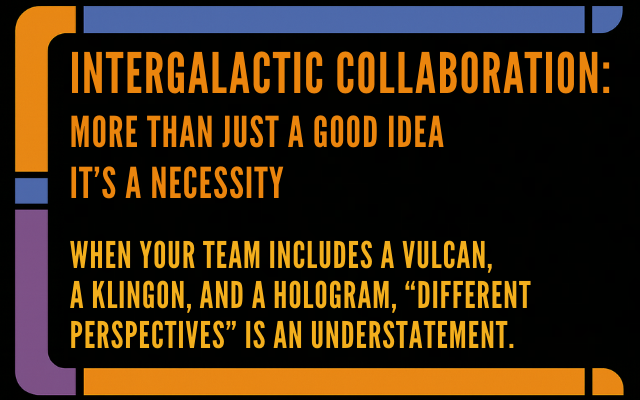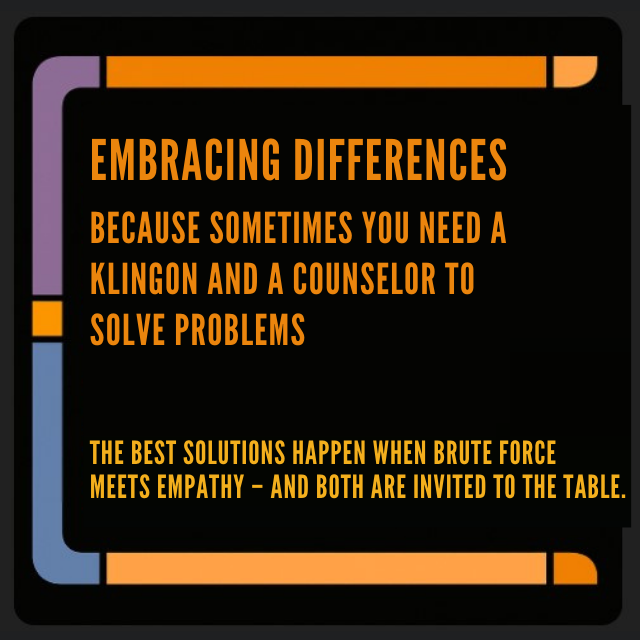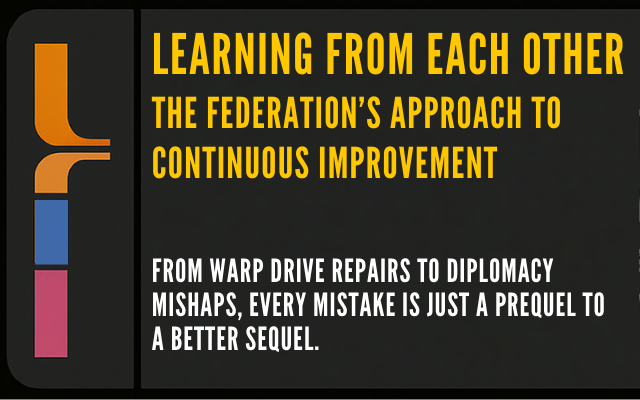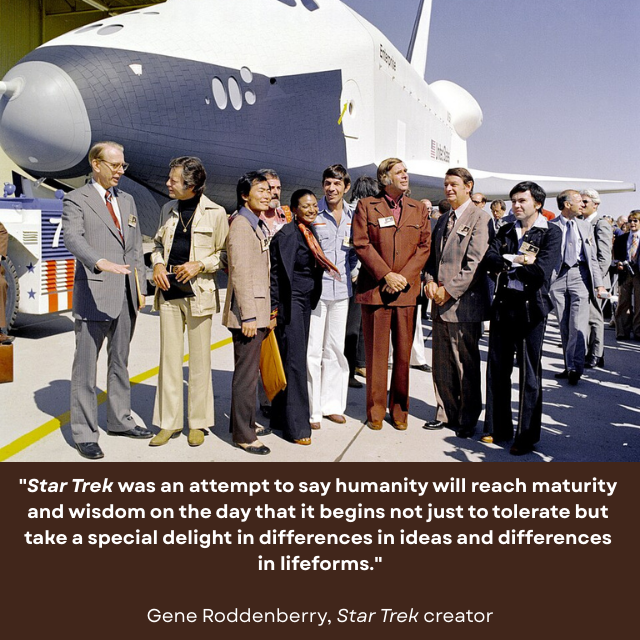- +1 (267) 368-7090
- contact@matcgroup.com
-
53 Knightsbridge Rd,
STE 216
Piscataway, NJ 08854.
Today is Star Trek Day! Let’s celebrate the premiere of OG Star Trek (1966) by learning lessons from Starfleet’s diversity.
When you think of Star Trek, you probably imagine a shiny spaceship zooming through the cosmos, exploring strange new worlds, and seeking out new life and new civilizations. But buried under the glitz of warp drives and Klingon ship battles is a core value that’s even more powerful: diversity. And not just “diversity” as a buzzword we throw around during corporate seminars. I’m talking about an actual, bona fide commitment to fostering an inclusive environment where diverse species and cultures can share knowledge, solve problems, and collaborate on an intergalactic scale.
So, how does Starfleet, the galaxy’s most elite military and scientific organization, encourage diversity and inclusion in knowledge-sharing? And, more importantly, what can we, mere mortals in the business world, learn from their highly advanced (and apparently extremely chill) approach to teamwork?
If you’re a Federation officer, your team could consist of a Vulcan, a human, a Trill, a Betazoid, and a hologram. Throw in a few Klingons, a couple of Andorians, and maybe a shape-shifting Changeling or two, and you’ve got the perfect storm of different cultures, languages, and worldviews. On paper, this sounds like a recipe for disaster, like mixing oil and water with way more high-stakes diplomacy and laser beam battles.
Starfleet understands something that many companies still struggle to comprehend: diversity isn’t just an afterthought, but the secret sauce for innovation. The crews of the USS Enterprise (pick your iteration), USS Voyager, the Deep Space Nine station, etc., constantly confront new, often dangerous, challenges that require a variety of perspectives to solve. Think about it: who else but Spock, with his cold logic and alien brain, could have solved that problem with the Romulans in the original series? Or how about Worf’s leadership skills, which were crucial for overcoming interstellar tensions (while also giving us great moments of Klingon culture)?

In Starfleet, the value of diversity is built into the very structure of its teams. Everyone brings something unique to the table, and each contribution, no matter how seemingly small, plays a key role in resolving a crisis. Imagine if the Enterprise was just made up of a bunch of humans. Where would they be without the insights of Data’s positronic brain or the keen intuition of Deanna Troi? Probably stuck in a time loop – again.
Now, you might be thinking, “Sure, Star Trek is great at showing diverse characters, but do they really talk to each other?” You bet they do, and that’s another lesson for the business world.
Take the example of the Enterprise’s legendary meetings. Sure, they may involve some melodramatic monologues and a lot of really intense eye contact, but they’re always an open forum for everyone to share their perspectives. Captain Picard doesn’t just sit behind his desk barking orders. He listens to his crew. Whether it’s Worf offering up his honest (and often hilarious) take on Klingon diplomacy, or Data offering an extremely logical approach to a moral dilemma, there’s a clear understanding that diverse viewpoints not only matter but are essential to effective decision-making.

In today’s workplaces, that kind of open communication is vital. Encouraging employees from diverse backgrounds to share their ideas promotes creativity and builds stronger team bonds, in addition to solving problems. Imagine if the Enterprise crew didn’t openly communicate: Picard would be a bit like that boss who sends passive-aggressive emails, and everyone else would be awkwardly trying to figure out how to make it work. It’s much more efficient (and much less stressful) when everyone feels comfortable speaking up and contributing to the discussion.
In Starfleet, embracing diversity isn’t just tolerated. It’s celebrated. Sure, you might not agree with everything your colleagues say (I’m looking at you, Klingon warriors), but Starfleet recognizes that each species brings something to the table. Why? Because the best solutions are often the result of combining radically different approaches.
For example, consider the number of times Captain Sisko, the only human who could handle the likes of Quark, must navigate the strange dance of diplomacy with the Ferengi. Despite their antagonistic tendencies, Sisko often finds a way to use their unique perspectives to resolve conflicts in creative ways.

In the workplace, this translates into actively valuing different ideas and viewpoints. Instead of trying to make everyone think the same way (let’s be real, that’s never going to happen), leaders create a culture where everyone feels empowered to bring their unique strengths to the table. When you allow people to work from their strengths, you create an environment where everyone’s contributions are not just heard but genuinely valued.
One of the most fascinating aspects of Star Trek is how the Federation continues to evolve. There’s a clear commitment to learning from past mistakes, improving, and adapting. From Starfleet officers attending advanced courses at the Academy to the very nature of their missions, there’s a recognition that diversity and knowledge-sharing make the organization smarter, stronger, and more capable.

That’s something we can all learn from. Cultivating an environment where employees learn from each other’s experiences, share expertise, and constantly improve leads to a more resilient and innovative organization. Just as the crew of the Enterprise occasionally messes up and learns from it (cough, Picard and the Borg, cough), modern businesses should foster a culture of continuous improvement, where knowledge sharing solves today’s problems and prepares for tomorrow’s challenges.
So, what can you take away from Starfleet’s approach to diversity and inclusion? Here’s the bold takeaway:

Whether you’re solving a crisis involving Romulans, Klingons, or just some classic office politics, the lesson is the same: diverse teams are stronger teams.
So, beam up the diversity, include everyone in the knowledge-sharing process, and boldly go where no one has gone before (while celebrating how cool it is that you get to work with all these amazing, unique individuals).
How Documentation and Training Helped the Rebels Blow Up the Death Star
Tackling Racial Disparities in Instructional Design
Modern Training: The Key to Employee Engagement and Company Growth
“18 Hopeful Quotes To Celebrate Gene Roddenberry’s Birthday.” Startrek.com. Accessed 8/18/25. https://www.startrek.com/gallery/10-hopeful-quotes-to-celebrate-gene-roddenberrys-birthday
Memory Alpha. Accessed 8/18/25. https://memory-alpha.fandom.com/wiki/Portal:Main